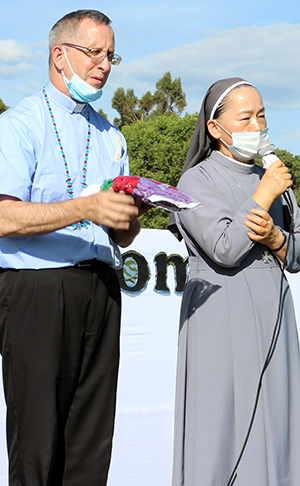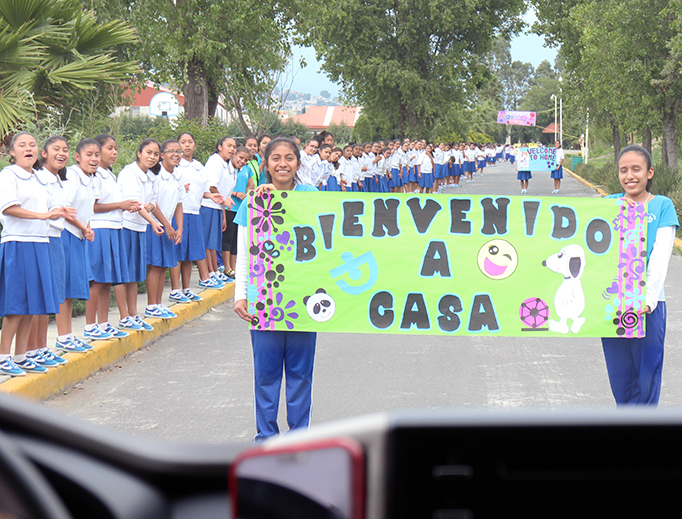Entering the Fields of Poverty and Resurrection
“Time here is like Magdalene’s perfume; it is precious for us.”

In an empty chapel in weather-miserable Banneux, Belgium, Aloysius Schwartz made a vow to spend the remainder of his life serving the humiliated and disregarded. Louvain’s lone American seminarian had a streak to him. “Al” was disarmingly direct and even bull-headed, but from an early age, he manifested holiness. So when he consecrated his life that night to the Virgin of the Poor at her apparition site, there would be no reneging.
Following his ordination in 1957 in Washington, D.C., where he was raised by humble and hard-working parents, he was told of a dire need for priests in war-decimated Korea. He wrote a letter expressing a willingness to lend a hand as a fresh-faced priest. Bishop John Choi wrote back: Come. We need you now in Busan.
On Dec. 8, 1957, “Father Al” looked for the first time into the faces of the Korean poor and saw “eyes burned with a fierce, scared, hunted-animal expression.” He tried to say annyeong (hello) to a few boys and was jarred by what seemed animalistic responses. A few spoke, and he heard terror in their voices. He walked further down the road and saw squatter huts and child-scavengers moving like zombies from trash pile to trash pile. He crawled into a tent stuffed with four men who had contracted tuberculosis. The smell of excrement, garbage and decaying animals hung heavy in the air.
He had walked into hell. And he exhaled — alas, he was home.
The honeymoon of his priesthood took birth on the brokenhearted street.
Thereafter, for 35 years, he became like Atlas, stooping down and reaching for hollowed-out souls. He knew by placing the poverty-stricken on his back that they could be closer to God — that they would finally begin to understand his love for them. Venerable Aloysius Schwartz’s cause for sainthood is now under consideration.
“It requires faith of the deepest kind to see God present in the person of the poor,” he wrote during his first year in Busan, Korea. “It requires the faith of the centurion, for example, who could look up at the crucified figure of Christ upon the cross ... who was a leper, as one struck by God, and say, ‘Indeed this was the son of God.’”
In the process of helping to heal the war-wounded soul of Korea, “Father Al” fashioned one of the most remarkable non-governmentally-funded services to the poor in the history of the world. In a life cut short by Lou Gehrig’s Disease (he died in 1992 at the age of 61), Father Al begged for tens of millions of dollars to build hospitals, dormitories, tubercular wards, orphanages, gymnasiums, schools and churches. His schematic would eventually pull nearly 200,000 of the poor from abject poverty, many of whom lived in trash dumps with names like Smokey Mountain and Ragpickers Camp in Korea and the Philippines.
Where Mother Teresa picked the dying man off the street, Father Al tried to make sure he was never there. He knew if he could raise up and educate the poor, that they could one day return to rebuild their impoverished homeland. Catholic Boystowns or Girlstowns would help to engineer them into accountants, contractors, musicians, mechanics and even priests or nuns. The possibilities for “man fully alive” were limitless to Father Al, but the work to make it happen was both relentless and dangerous. He was beaten up, harassed by gangs, calumniated, and accused by a bishop of redirecting money that would have gone into his own diocese.
“I am always under extraordinary inner pressure with so many decisions, problems, responsibilities and worries. I seem to wear an invisible ‘crown of thorns,’” he wrote to his most intimate spiritual companion, a Carmelite sister named Mother Gertrude. “But this ‘crown of thorns’ is a grace and a privilege. I never cease to give [it] praise and gratitude.”
President Ronald Reagan and Pope St. John Paul II were astounded by the volume of his poverty-breaking work that eventually was instituted into six other countries. Within a decade of his start in Korea, more than one million people became donors to his mission, now spearheaded by World Villages for Children and guided by Father Al’s spiritual daughters, the Sisters of Mary. Aware of how the large number of donors could leave him open to suspicions of misusing funds, he moved into a hut and ignited an even more intense ascetical lifestyle. He fully resembled the people he served.
Father Al also knew that his vocation would lack spiritual vibrancy, like a governmental social justice department, unless it were rooted in the Virgin of the Poor and “Christ, the Starved Man.” So he did what he thought they would ask of him — he committed to mortifications and an intense devotion to the Holy Eucharist and to prayer to act as seedbeds. He daily prayed the Rosary and his Office. He made it a point to be available to the poor at all times.
Father Dan Leary
Nearly three decades after Father Al’s death, Father Dan Leary, a priest for 23 years in the Archdiocese of Washington, was recently granted permission by Archbishop Wilton Gregory to spend the next 2-3 years as Chaplain to the Sisters of Mary and their communities throughout the world. On July 6, he touched down in Chalco, Mexico, the Sisters of Mary’s home to 3,300 teenage girls.
“Early on in seminary it was a grace for me to be given the opportunity to spend time with the Sisters of Mary in Chalco. It was a tremendous encounter, incredibly impactful,” Father Leary said. “I saw that the sisters wanted to awaken in these children their full potential as beloved children of God. They wanted to show them who they were, what their purpose was and their dignity as ones dearly beloved by God.”
Father Leary has walked into a dimension unseen in America or the West. For starters, he has encountered teenagers without mobile phones or earbuds. Each prays the Rosary at 7 P.M. in what sounds like a harmonious chorus that reverberates like orchestral hives of bees. They are taught fully-accredited classes by some of the finest instructors in Mexico and receive catechesis from the sisters. Their sports programs, musicians and orchestra are among the finest in the country.
Visitors to Boystown and Girlstowns frequently report back a throbbing type of joy, heightened by the knowledge that the children were lifted from harsh lives of poverty.
Many have worked fields, barefoot, at the age of 8 or 9 and returned home to find no food on the table. Almost all have had the fear of not knowing the source of their next meal. For the five years the sisters will have them, they teach, nourish, catechize, play with, jog with, and pray with them. They do not stop. The eloquence of their maternal love — given ever so slowly, so tenderly — pulls away layer after layer of wounds and horrors too graphic for this writing.
“Time here is like Magdalene’s perfume; it is precious for us,” said Sr. Margie Cheong, the Korean-born sister and head of the Latin American communities. “We give all we are to the children.”
The sisters know the secret: persevering love stirs hearts to healing. The congregation is scattered throughout South and Central America and the Far East like spilled chalices of the Lord’s Blood. It is grueling work. The Sisters of Mary are considered by many to be among the hardest-working congregations in the world.
Brazilian-born Sr. Marinei (pronounced “Mar-en-ae”), is just one of the 370 sisters Father Leary now works alongside. She described what the sisters must do to lift up the children. “My thoughts, my hurts — it is all nothing. I must die to everything to be filled with Christ [to serve them],” she said. “To live poverty means that I must accept a certain death ... now, it is not easy for me, but I know I need to die several times a day. I need to leave behind everything that I am.
“But that is the Gospel — I leave everything — mother, father, all that I have. This is what Jesus asks. It is difficult, but these difficulties are great gifts. Because they allow me to offer myself fully to him and these girls.”
Throughout his ministry, Father Leary has been drawn intensely to the poor and broken. During the temporary closing of parishes in the springtime, the former pastor of St. Andrew the Apostle parish organized drive-in Eucharistic Adoration and confession opportunities in the church parking lot and a 52-mile fundraising walk for the poor. He has worked alongside the Missionaries of Charity and the Mustard Seed Communities, which serve the profoundly physically and developmentally disabled. When he recently received donations of thousands of loaves of bread, he made recurring 120-mile round trips for pick-up and distribution to centers, parishes and pantries that serve low-income families in the Archdiocese of Washington.
“Father Al was pretty simple and straightforward about the mission. He said, ‘We believe in Jesus, we love Jesus, and we do what Jesus did,’” Father Leary said. “Christ chose to live in poverty and die in poverty. I know Matthew 25 was a driving force for Mother Teresa and for Father Al. I guess it’s what’s inspired me as well — to encounter Christ in the poor. The poor deserve spiritual fathers who love them.
“I’m grateful to God for calling me. I’m at peace. He wants something more from me. I know the Lord has a plan, so I’ll just leave it all with Him.”
Note: World Villages for Children (WVC) is a non-profit organization that financially supports the Sisters of Mary as they help children break free from a life of poverty. WVC provides food, shelter, clothing, medical expenses, Catholic education, and vocational training to more than 20,000 children in Boystowns and Girlstowns in seven different countries around the world. If you would like to donate to World Villages for Children, please go to www.worldvillages.org/donate.
- Keywords:
- father dan leary
- mexico



















